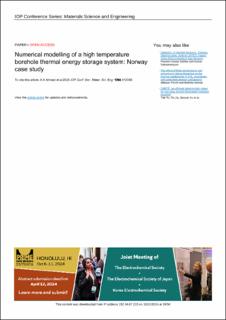| dc.contributor.author | Awadelseed, Abdelazim Abbas Ahmed | |
| dc.contributor.author | Assadi, Mohsen | |
| dc.contributor.author | Gholami, Raoof | |
| dc.contributor.author | Ahmed, Naveed | |
| dc.date.accessioned | 2024-02-01T13:34:24Z | |
| dc.date.available | 2024-02-01T13:34:24Z | |
| dc.date.created | 2024-01-03T09:03:18Z | |
| dc.date.issued | 2023 | |
| dc.identifier.citation | Ahmedm A.A.A., Assadi, M., Gholami, R. and Ahmed, N. (2023) Numerical modelling of a high temperature borehole thermal energy storage system: Norway case study. IOP Conference Series: Materials Science and Engineering, 1294, 012059 | en_US |
| dc.identifier.issn | 1757-8981 | |
| dc.identifier.uri | https://hdl.handle.net/11250/3115082 | |
| dc.description.abstract | Global warming is threatening life on earth. Utilising renewable energy is considered as the most effective measure to minimise anthropogenic CO2 emissions. High-temperature borehole thermal energy storage (BTES) systems have a world-wide potential to reduce energy consumption, increase energy utilisation of waste heat and provide efficient seasonal heat storage. Hybrid application of BTES and solar energy leads to net zero emissions. In this study HT-BTES is evaluated for seasonal thermal heat storage and recovery. To this end, a CMG STARS model was built and validated using the existing 100-wells BTES system in Norway. Then, the model was used to evaluate BTES thermal performance and thermal recovery efficiency. Sensitivity analysis was also conducted to study the dynamics of storage temperature in the BTES under different operating conditions, such as heat carrier flow rate, injection temperature, and charging period. Results of this case study show that the model-predicted temperatures during charging and discharging are in good agreement with the existing BTES system. In 5 years of operation, 35.5% of the heat injected into the BTES system was recovered, while the significant heat remained in the borehole region and lost to surrounding rock (64.5%). BTES was found very sensitive to flow rate, the charging period and injection temperature. Borehole depth has a minimal effect on BTES storage temperature at constant studied injection temperature. | en_US |
| dc.language.iso | eng | en_US |
| dc.publisher | IOP Publishing | en_US |
| dc.rights | Navngivelse 4.0 Internasjonal | * |
| dc.rights.uri | http://creativecommons.org/licenses/by/4.0/deed.no | * |
| dc.subject | global oppvarming | en_US |
| dc.subject | fornybar energi | en_US |
| dc.title | Numerical modelling of a high temperature borehole thermal energy storage system: Norway case study | en_US |
| dc.type | Peer reviewed | en_US |
| dc.type | Journal article | en_US |
| dc.description.version | publishedVersion | en_US |
| dc.subject.nsi | VDP::Teknologi: 500 | en_US |
| dc.source.volume | 1294 | en_US |
| dc.source.journal | IOP Conference Series: Materials Science and Engineering | en_US |
| dc.identifier.doi | 10.1088/1757-899X/1294/1/012059 | |
| dc.identifier.cristin | 2219528 | |
| dc.source.articlenumber | 012059 | en_US |
| cristin.ispublished | true | |
| cristin.fulltext | original | |
| cristin.qualitycode | 1 | |

